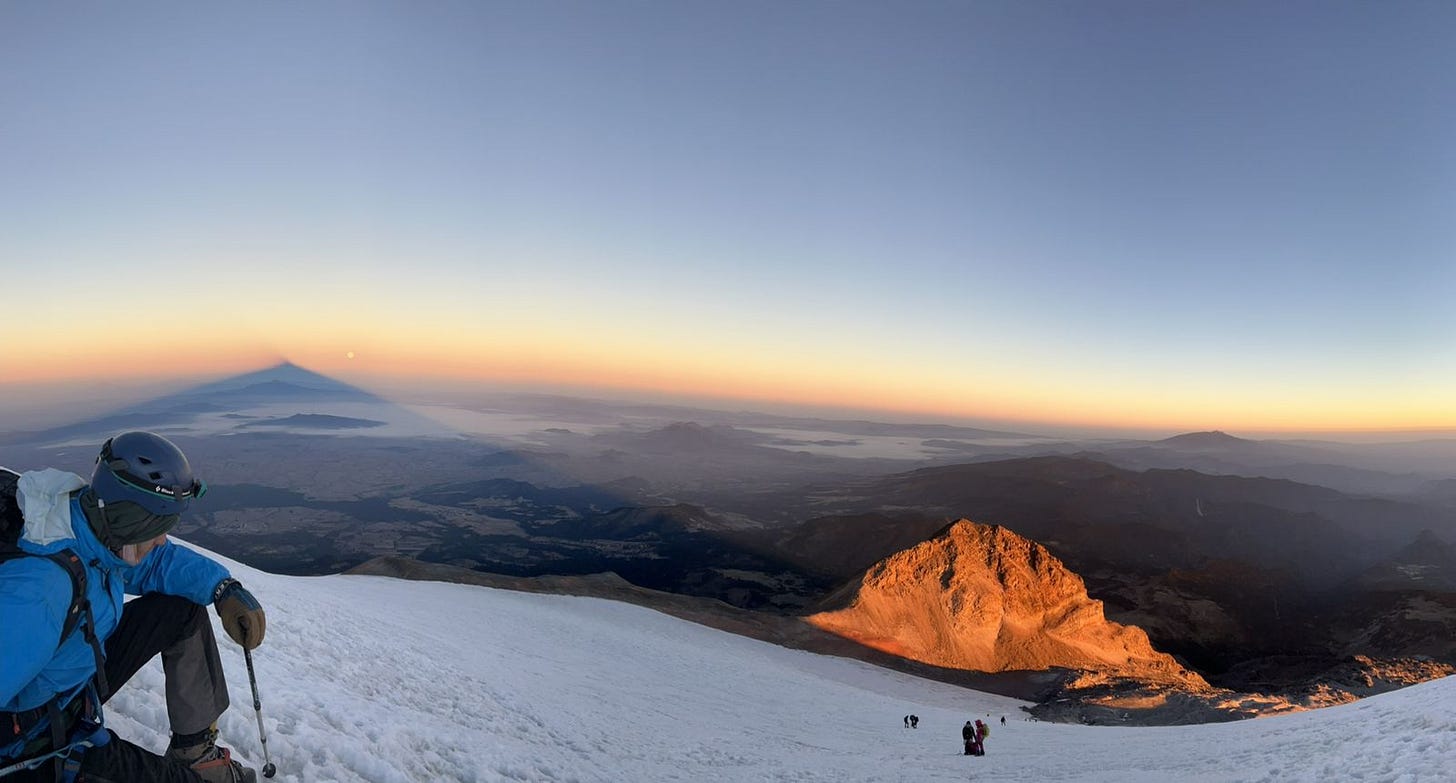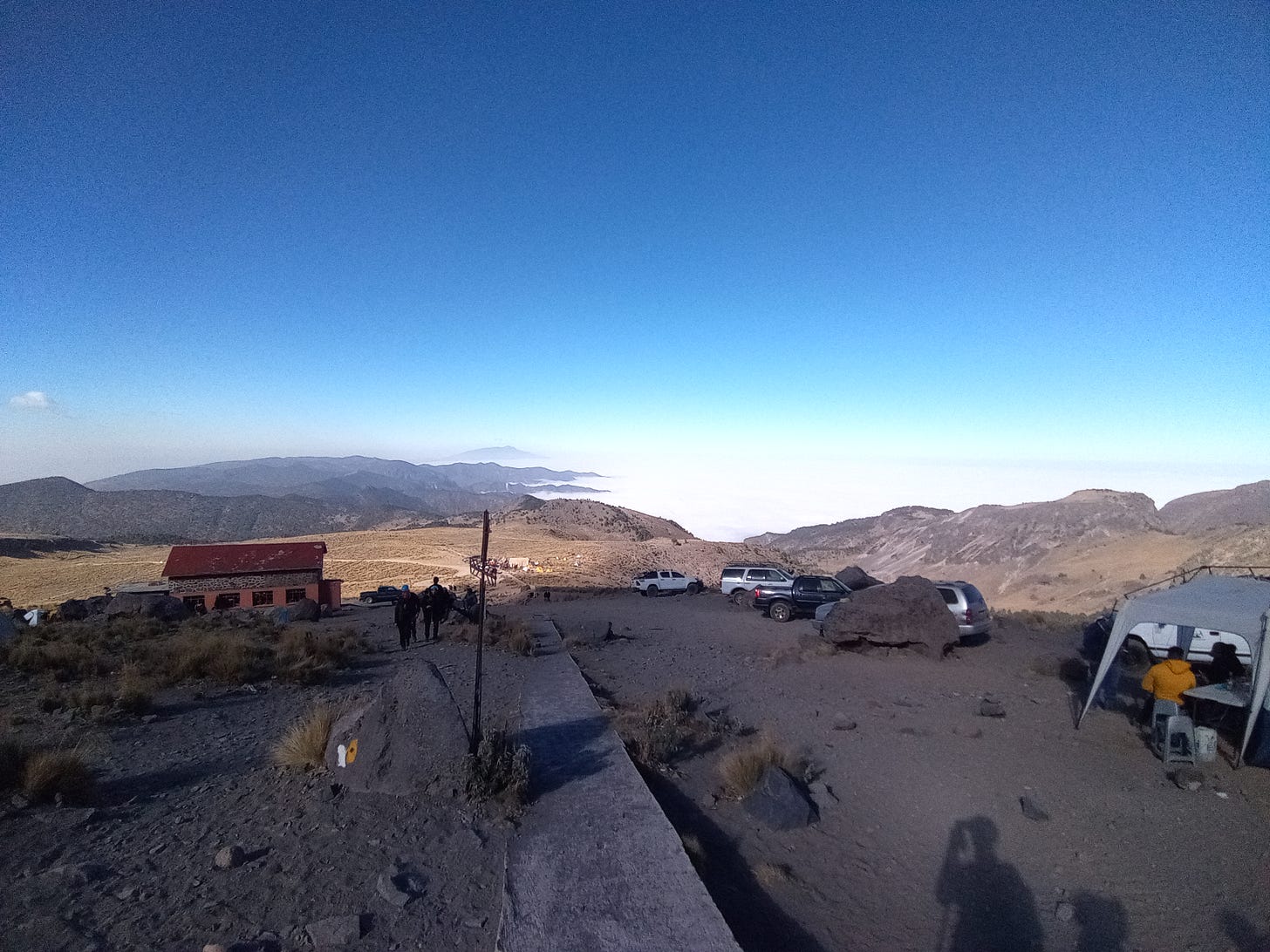The dust-filled pickup truck tilted further and further as we backed into the ditch. Finally, the opposing truck squeezed through the narrow gap we had formed and we continued our journey upwards. Bump, bounce, bump. Washroom break. Bounce, bump, bounce. Base camp, 4,270m.
The air felt amazing. Nothing like the 6 a.m. smog of Mexico City’s station Metro Agricola Oriental where I first met the rest of the crew. They had arrived late in true Mexican fashion, but I had expected it and got a pan dulce and fruit juice from the nearby puesto to help me wait. There were seven of us. An ultramarathon runner and his girlfriend. The girl, Futin, who invited me after we chatted at the climbing gym. Her childhood best friend, now cardiologist and night shift supervisor at a Mexico City hospital. And of course, our two experienced mountain guides. I was excited, nervous and quite unprepared.
That afternoon we did an acclimatization hike. I felt good. We built our tents, ate a bit and called it an early night. With my alarm set, I fell asleep to the thoughts of falling into crevasses or rescuing teammates from them. What happened was far less dramatic yet equally impactful.
1 a.m. -15°C. Day’s objective: Summit Mexico’s tallest peak, Pico Orizaba, 5,636m.
We all ate some of our snacks before following the trail of headlamps up the mountain. I had found not too far from my house in Mexico City a convenience store selling nuts and sweets in bulk. The store’s left wall shelf was filled with glass jars containing a wide selection of chocolate-covered fruits, matcha-flavoured sweets and salted nuts. Given the excuse of the next day’s adventure, I let my inner child fill a variety of paper bags with the most appealing snacks. Somehow, the mix of matcha raisins, chocolate nuts and vanilla wafers was slightly off-putting after having been thoroughly shaken together in my backpack’s Tupperware.
After walking over a short section of concrete tiles covering an aqueduct, the trail turned into a steep ascent that would take our group several hours. This unmarked trail section, known as the Labyrinth, winded its way up through an expansive boulder field to eventually reach the foot of the glacier.
Within the first two hours, one of our team members decided to turn around. Her fingers and toes were freezing. One of the two mountain guides accompanied her back to the refuge reducing our group to just five people.
As we neared the 5000 m mark, progressed slowed. The high altitude reduced our previously continuous strides to individual steps punctuated by little pauses. We struggled but were thankful to not be experiencing any signs of altitude sickness. Just an hour prior, we had met a nauseated climber sitting on the trail’s edge, trying to return to base camp. Her group and mountain guides had continued on without her when she and a friend decided to turn around. We later learned they vomited multiple times during their descent. Why a guide hadn’t stuck with them to help them down the windy trail still boggles my mind.
As we reached the glacier’s base, my first signs of trouble appeared. The rest of the group had quickly donned their crampons and ice axes while I used a washroom and snack break to take in the situation. I had the slightest of headaches and the last 30 minutes had been the most challenging yet. After having spent most of the day with the guide at the head of the group, I had fallen behind and had to make multiple breaks to catch my breath. The path ahead, following a straight line up the imposing glacier, seemed ridiculously long. For the first time that day, I wondered if I could make it to the summit. Realizing that such thoughts were pointless, I quickly pushed them down and returned to the group with a renewed determination to make the summit.
Assisted by our crampons and ice axes, we trudged up the slope. Our guide decided that we did not need to be roped in given the exceedingly low risk of unmarked crevasses. We were told to simply be careful of not falling backwards since if we were to start tumbling down the 40° slope, it would quickly become impossible to arrest our fall.
Without the constraints of a rope, our group spread out. The ultramarathon runner and my climbing gym friend passed ahead. The guide being the slowest took up the rear moving at a very slow yet steady pace. The cardiologist and I, in the middle, stayed together for a while. However, the increasing frequency of my breaks forced him to eventually continue on without me. Before parting ways, he took this beautiful picture of the peak’s shadow during the sunrise.

Now alone, without anyone to push me along, I took breaks every second step. The slight headache had settled into an unmistakable dull pain that I ignored trying to convince myself that it was nothing to be concerned about. The slope steepened and the trail transitioned to switchbacks.
As the mental exertion to keep on taking steps increased, doubts that I had been suppressing flooded my mind. At this pace and with everyone else well ahead, could I really make it to the summit? Should I be concerned about the risk of my headache getting worse? At this level of exhaustion, would I be able to arrest a fall if I slipped? Eventually, the doubts and extreme fatigue overpowered my desire to reach the summit. At ~5,300 m, just 300 m from the summit, I turned around.
On my way down, another solo climber encouraged me to not give up. Following his advice, I spent 15 minutes going uphill before deciding turn around again. Eventually, I reached our mountain guide and together we descended to the foot of the glacier to wait for the rest of the group. I napped to try to make my headache go away. We spoke about his career in the Mexican military. Having now retired, he works as a bodyguard for politicians and high-risk people. It was interesting to hear about the type of skills required for the job. He had fascinating stories from psychoanalyzing criminals to walking the fine line of not getting recruited by the mafia while simultaneously not angering them.
The days that followed the trip I kept asking myself if I could have kept pushing towards the summit. When I told my friends the story, I emphasized my headache and not wanting to take risks as key factors in my decision to turn around. In reality, those factors were secondary. It was the overwhelming mental exertion of forcing my body to continue moving upwards against its will that turned me around.
If I had been more mentally strong, could I have reached the summit?
A few weeks later, my friend Adele and I attempted to summit a 23 pitch rock-climbing route in Potrero Chico, Mexico. After struggling up pitch 20, she hesitatingly announced that she wasn’t sure if she could keep going due to the heat and fatigue. We decided to turn around. With only 3 pitches left, perhaps I should have pushed her to keep going as I sometimes wish someone had done for me on El Pico Orizaba. Or perhaps, in both cases, turning around was the safe and smart decision.


